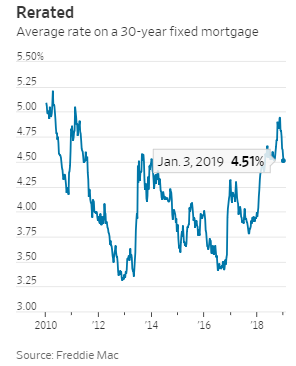Housing Market Is Canary in Interest-Rate Coal Mine
Mortgage rates aren’t up by much but home sales are down, signaling how dependent on low rates the U.S. economy has become
By Justin Lahart
.

A builder works on a home under construction in Denver last summer. The past year wasn’t a good one for the U.S. housing market. Photo: David Zalubowski/Associated Press
The funk in the housing market could be an important signal about the U.S. economy’s sensitivity to rising interest rates. So could any rebound now that rates have retreated somewhat.
Last year wasn’t a good one for housing. Through October (the most recent data available, thanks to the government shutdown), sales of new single-family homes were down 12% from a year earlier. Sales of previously owned homes were down by 7% through November. New-home construction slowed, home-price gains moderated and sentiment among home builders’ slipped to a three-year low.
One important culprit appears to be higher borrowing costs driven by the Federal Reserve’s interest-rate increases. The average rate on a 30-year fixed-rate mortgage climbed to as much as 4.9% in November, its highest level since 2011, versus 4% at the start of the year. For a $500,000 mortgage, that boosted the monthly payment by $266 to $2,654. The mortgage rate has since fallen to 4.5%.

Still, the market reaction was somewhat surprising. Today’s rate is still low by historical standards and most home buyers, benefiting from a strong jobs market, should be able to shoulder the increased burden. But since rates were as low at 3.4% as recently at 2016, some homeowners have a strong incentive to stay put, much as they might want to move. This suggests that housing may have grown dependent on the low-rate environment that has prevailed since the 2008 financial crisis.
There are other factors affecting the housing market such as last year’s tax bill, which limited deductibility for mortgage interest and state and local taxes. And since most home buyers focus more on monthly payments than the price of the house, home sales will slow further or prices will fall until payments even out.
But the bigger concern is that the whole economy has become dependent on low rates and that housing is just the first area to show it. Auto sales, which were bolstered by years of easy financing, have leveled off. The biggest risk could be for corporations, which saw big debt buildups during the last decade. Rising rates—and the lower tax-deductibility businesses get from borrowing—threaten to not only make companies more cautious about debt-financed investments or acquisitions, as they have with consumers, but may also make it hard for some heavily indebted companies to fund operations and or even stay afloat.
The Fed is worried enough about the economy’s rate sensitivity that it expects to slow its tightening campaign. At the same time, though, policy makers have to be concerned that continuing to feed the economy’s low-rate addiction could endanger its health. Housing may just have been the start. This year could exhibit more withdrawal symptoms.
0 comments:
Publicar un comentario